Students must practice these AP Inter 1st Year Economics Important Questions 3rd Lesson Theory of Demand to boost their exam preparation.
AP Inter 1st Year Economics Important Questions 3rd Lesson Theory of Demand
Long Answer Questions
Question 1.
Explain the Law of Demand and examine exceptions to it.
Answer:
Demand is the desire accompanied by ability and willingness to buy the product.
“By demand, we mean the various quantities of a given commodity or service, which consumers would buy in one market in a given period of time at various prices of the good” . -Bober
“The law of demand states that there is an inverse or opposite relationship between price and quantity demanded, other things remaining the same. The law states that demand curves slopes downwards from left to right.”
Definition: “Other things being equal, the quantity demanded expands with fall in price and contracts with a rise in price” – Samuelson.
Determinants of demand: The demand for a product depends upon various factors. They are price of the products, income of consumer, prices of related goods, the habits of the consumers, advertising expenditure of the firm, etc. The functional or mathematical relationship between determinants of demand and demand of a good is known as demand function.
DA = f(Pay,Pr,T,A)
DA = Demand of product A
PA = Price of A
Y = Income of the consumer
Pr = Price of related goods
T = Tastes of the consumer
A = Advertising expenditure
Assumptions of Law of Demand: The Law of demand is based on a number of assumptions.
- There are no changes in the tastes and fashions of the consumers.
- People’s incomes are constant.
- The prices of related products remain the same.
- There are no substitutes to the product.
- There is no possibility of price changes in future.
Demand Schedule: Demand schedule is a table which shows different prices of the good and quantities demanded of the good at those prices. It is of two types. They are
- Individual demand schedule
- Market demand schedule
| Price of Apple (Rs) | Quantity demand (Kg) |
| 5 4 3 2 1 |
3 7 12 18 25 |
The above table shows than when the price is high (Rs 5) quantity is demanded is less and when price is low (Rs. 1) quantity is demanded is more.
Demand Curve: Demand curve can be shown diagramatically with the help of demand schedule.
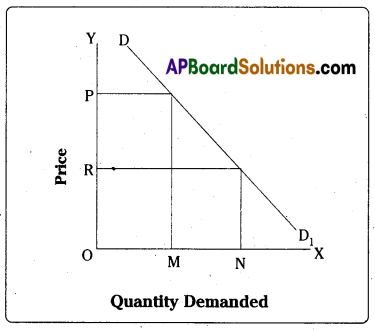
In the above diagram when the price is OP, the demand is OM. When the price has decreased from OP to OR demand has expanded from OM to ON. In other words, the above diagram shows that demand curve slopes downwards from left to right.
![]()
Exceptions to the Law of Demand:
1. Giffen goods: The law of demand is not applicable to Giffen goods. In the case of Giffen goods, a fall in their price leads to a decrease in demand.
2. Veblen Goods (Prestige goods): The law of demand will not apply in the case of costly products purchased by rich people. If the price of costly diamonds purchased by rich people increases, the demand for such diamonds also increases.
3. Speculation: If the price of the good is increasing and likely to increase further in future, speculators purchase larger quantity even at a higher price.
4. Illusion: Some consumers, with wrong illusion, purchase less quantity of a good whose price has decreased with the wrong illusion that quality has also been reduced.
Question 2.
What is a Demand Function ? What are the factors that determine the demand for a good ? [May 2018]
Answer:
Demand function is a mathematical function (expression) which shows the functional relationship between the determinants of demand and demand of the good.
Demand functions:
Dx = f(Px, P1 ………… Pn Y, T)
where Dx = Demand of good X
Px = Price of Good X
Y = Income of the Consumer
T = Tastes of the Consumer
F = Functional Relationship
P1…. Pn = Prices of related goods.
Determinants of Demand: Demand is a dependent variable and the demand for a good generally depends upon the following factors.
1) Price of the good: The most important determinant of demand of any good is the price. Price and demand are inversely related. If price increases, demand contracts and if price decreases demand expands.
2) Prices of Related goods (Substitutes & Complementary Goods): Demand for a good depends not only on its price but also on the prices of substitutes and complementary goods. If the price of tea (substitute of coffee) decreases, demand for coffee decreases. In the same way, when the price of Jam increases (complementary good of Bread), demand for Jam decreases.
3) Iftcome of the consumer: Another important determinant of demand is the income of the consumer. Income and demand are directly related. If income increases demand increases and vice versa.
4) Tastes and preferences of the consumers: A change in the tastes and preferences of the consumers leads to a change demand for goods. A change in the preference and tastes of the consumer towards cell phones results in a fall in the demand for landline phones.
5) Population: The size of population of the country is another determinant of demand. If population increases demand for many goods increases.
6) Technology changes: An improvement in technology by leading to an improvement in quality and reduction cost of production and selling price, leads to an increases in demand.
7) Changes in weather conditions: Demand for a good is also determined by weather conditions. Air conditioners, cool drinks, etc. will have more / higher demand during summer. The demand for woolen clothes increases during winter.
8) State of Business: In a period of Economic depression, demand for goods contracts and in a period of Economic prosperity, the demand for goods increases.
Question 3.
Explain the Concept of Demand and various Types of Demand. (OR) Explain the three forms of demand.
Answer:
The term demand refers to the different quantities which a consumers is prepared (willing and able) to buy at different prices in a given market, at a given line and in a given place.
Other things remaining the same or constant, the law of demand states there is an inverse and opposite relationship between price and quantity demanded. In other words, at the law states that when price increases, demand contracts and if price decreases demand expands.
Demand is of 3 types.
- Price demand
- Income demand
- Cross demand.
1) Price Demand: Price Demand shows the relationship between changes in price and changes in the quantity demanded of the good.
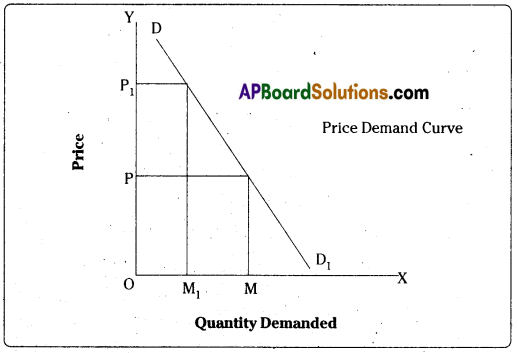
As shown in the above diagram. Price demand curve slopes downwards from left to right indicating inverse relationship between price and quantity demanded.
2) Income Demand: Income Demand shows the relationship between a change in the income of the consumer and a change in demand. An increase income leads to increase in demand and a decrease in income leads to a fall in demand. Goods are of 2 types. They are 1) Normal goods 2) Inferior goods.
Normal goods: In the ease of Normal goods, an increase in income leads to an increase in demand and vice versa. Income demand curve for normal goods slopes upwards from left to right as shown below.

Inferior goods: In the case of inferior goods, an increase in the income makes the consumer to purchase less of that good than before. Income demand curve for inferior goods slopes downwards from left to right as shown below.
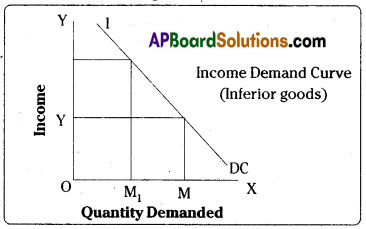
3. Cross Demand: Cross Demand shows the changes in demand of a good due to a change in the price of its related good. Related goods are of 2 types a) Substitutes b) Complementary goods.
E.g: Coffee, Tea. Cross Demand curve for substitutes slopes upwards as shown below.
Substitutes: Substitutes are those goods which are used in the place of another good.
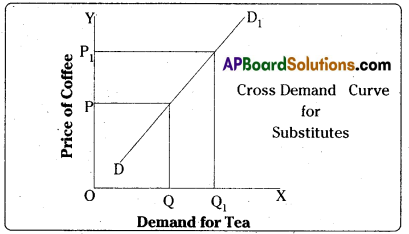
Complementary Goods: Complementary goods are two or more goods used simultaneously to satisfy the same want. E.g: Bread & Jam. Cross Demand curve for complementary goods slopes downwards from left to right as shown below.
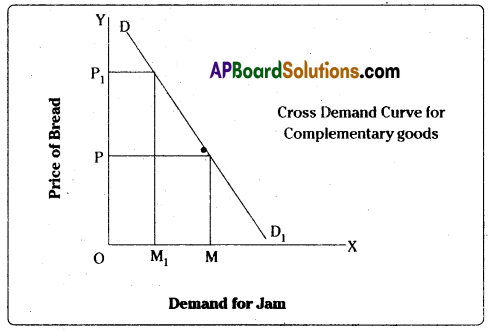
![]()
Question 4.
Define the Concept of Elasticity of Demand and explain the concepts of Price, Income and Cross Elasticity of Demand.
Answer:
The degree to which quantity demanded responds to a change in price is known as elasticity of demand.
In other words “The elasticity of demand is the ratio of the percentage change in the quantity demanded and the percentage change in price”.
Mathematically, it can be expressed as

Elasticity of Demand studies the relationship between proportionate or percentage change in demand and proportionate or percentage change in price. It is 3 types.
1) Price elasticity demand: Price elasticity of demand studies the relationship between proportionate change in price and proportionate change in demand. It explains the rate of change in demand for a given change in the price of commodity.

Price elasticity demand is of five types. They are
- Perfectly or infinite elastic demand (Ed = ∞ )
- Perfectly inelastic demand (Ed = 0)
- Unitary elastic demand (Ed = 1)
- Relatively elastic demand (Ed > 1)
- Relatively inelastic demand (Ed < 1)
2) Income elasticity of demand: Income elasticity of demand explains the relationship between percentage proportionate change in demand and percentage, proportionate change income.

Income elasticity of demand is positive for normal goods. But in the case of inferior goods, income elasticity of demand is negative.
3) Cross elasticity of demand: Cross elasticity of demand studies the relationship between percentage or proportionate change in demand of product (E.g: Coffee) because of a percentage or proportionate change in price of the other related good. (E.g: Tea)
Cross elasticity of demand =

Related goods are two types. They are
- Substitutes and,
- Complementary goods.
Question 5.
What is Price Elasticity of Demand ? Explain the various types of Price Elasticity of Demand.
Answer:
The degree to which quantity demanded responds to a change in price is known as elasticity of demand.
In other words the elasticity of demand is the ratio of the percentage change in the quantity demanded to the percentage change in price.
Mathematically, it can be expressed as price elasticity of demand (E) =

1) Price elasticity of demand: It shows the relationship between percentage of change quanlity demanded and percentage in price.

Types of price elasticity of demand: Basing on the percentage change in demand and percentage change in price, price elasticity of demand can be divided into following.
a) Perfectly elastic or Infinite elastic demand: A product will have perfectly elastic demand when demand changes infinitely due to slight change in price or no change in price. Demand is also said to be perfectly elastic, when infinite quantity can be purchased at the same price.
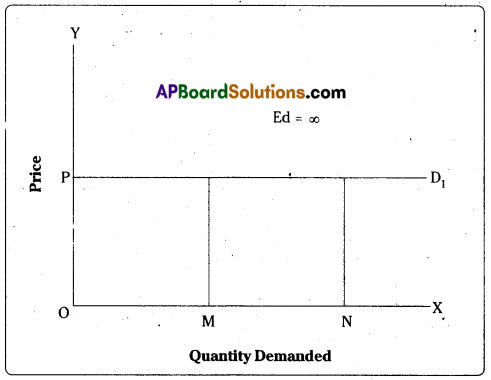
In the above diagram, demand has increased from OM to ON, even though there is no change in price. The demand curve is horizontal straight line parallel to X – axis so, Ed = ∞
b) Perfectly Inelastic or Zero elastic demand: If the demand for a product does not change even though price changes many times, such demand is called as perfectly inelastic demand.

In the above diagram, even though price has increased from OP to OP1, there is no change in demand (OM). The demand curve is vertical straight line parallel to Y – axis so, Ed = 0.
c) Relatively elastic demand: If the proportionate or percentage change in demand . is more than the proportionate or percentage change in price, it is called as relatively elastic demand.
Such a demand curve is more flater so, Ed > 1.
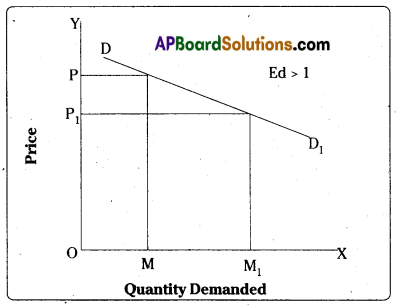
In the above diagram, when the price has decreased from OP to OP1, the increase in the demand is OM to OM1. Increase in demand (M, M1) is more than change in price PP1. So Ed >1.
4) Relatively inelastic demand: When the proportionate or percentage change in demand is less than proportionate or percentage change in price, it is called as relatively inelastic demand. Such demand curve is more steeper.

In the above diagram, when the price has increased from OP to OP1, the demand has decreased from OM to OM1. The amount of change in price (PP1) is more than the amount of change in demand (MM1) . So Ed < 1.
e) Unitary elastic demand: When the proportionate or percentage change in demand is equal to proportionate or percentage in price, it is called unitary elastic demand.
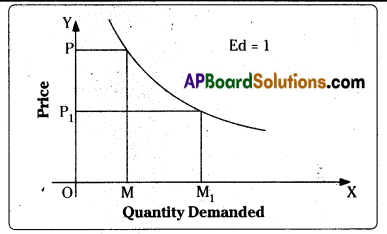
In the above diagram, when the price has decreased from QP to OP1 demand has increased from OM to OM1 The amount of change in demand M, M1 is equal to the amount of change in price P, P1 SO, Ed = 1
![]()
Question 6.
Explain the Three Methods of Measuring Price Elasticity of Demand.
Answer:
Price elasticity of demand shows the responsiveness of quantity demanded to changes in price. In other words, it is the ratio of proportionate change in quantity demanded and proportionate change in price.
Methods of calculating elasticity of demand:
1) Total: Outlay or Expenditure Method: This method is associated with the name of Alfred Marshall. Under this method Elasticity of demand of a good can be calculated / measured by finding out whether the expenditure on the good increases, decreases or remains constant with a change in the price of the good.
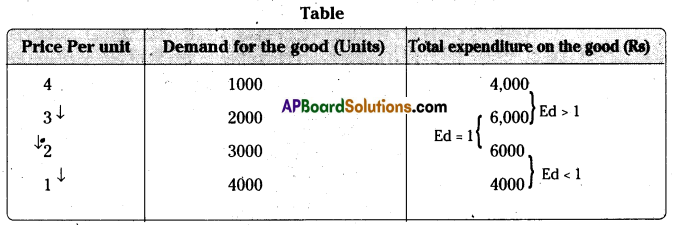
In the below diagram, on Y axis price is shown and X axis is outlay or expenditure made on the good is shown.
1) When the price has decreased 1st time from Rs. 4 to 3, the outlay or expenditure made on the good has increased from Rs. 4000 to Rs. 6000. If a decrease in price leads to an increase in expenditure (or vice versa) the good will have relatively elastic demand (Ed >1).
2) When the price has decreased 2nd time from Rs. 3 to Rs 2/-, there is no change in expenditure of outlay made on the good. In this way, if a change in price (either increase/decrease) leads to no change in expenditure or outlay or vice versa. The good will have unitary elastic demand (Ed =1).
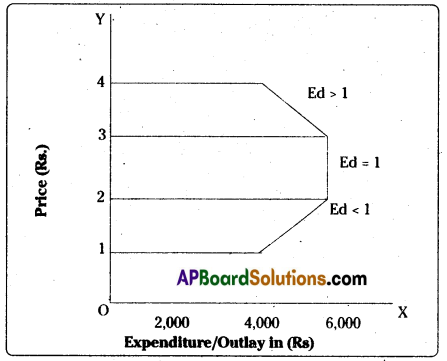
3) When the price has decreased 3rd time, from Rs. 2 to Rs. 1, the expenditure or outlay made on the good has also decreased from Rs. 6000 to Rs. 4000/-. In this way, if a decrease in price leads to decrease in expenditure/outlay or vice-versa, the good will have relatively inelastic demand (Ed < 1).
2. Point Method: This method was introduced by Alfred Marshall. Under this method, the elasticity of demand at a point can be calculated measured by dividing the (length of) lower segment of the demand curve with the (length of) upper segment of the demand curve. To calculate elasticity of demand, a point is placed on the demand curve and such point divides the demand curve into two parts namely, a lower part and an upper part.
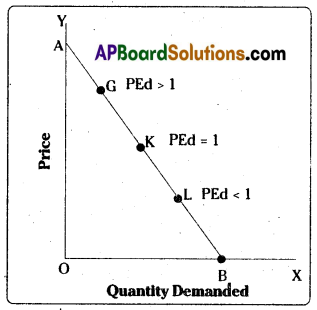
1) In the above diagram, at the middle point of the demand curve (K) PEd = 1. This is because at point K (the mid point) the lower segment of the demand curve (KB) is equal to the upper part of the Demand curve (KA).
KA/KB=1, PEd = 1
2) At a point above the middle point (G), Price elasticity of demand is greater than one (Ed > 1). This is because at point G the lower part of the demand curve, GB is more than the upper segment / part of the demand curve(GA). GB > GA, PE > 1. GB/GA = more than one, Ed > 1.
3) At a point below the mid point of the demand curve, price elasticity of demand is less than one. This is because at point L, the length of the lower segment of the demand curve (LB) is less than the length of the upper part of the demand curve (LA).
LB/LA = less than one, PE < 1.
3. Arc Method: Arc method is a method of calculating elasticity of demand in which elasticity is calculated in a portion or segment of the demand curve between two points of the demand curve. In other words, in this method, elasticity is calculated at the mid point of an arc of the demand curve.
Generally, arc method is used when there are frequent changes in price and demand quantities in a very short period. This method is used if there is difficulty in the collection of data or data gaps.
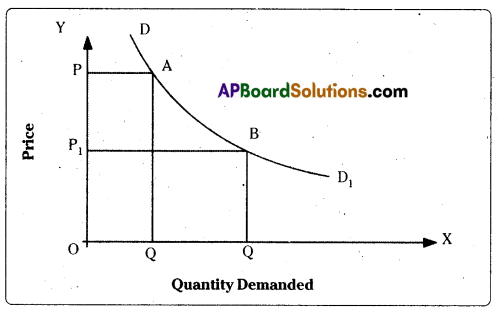
The formula for calculating elasticity of demand lender Arc method.

Question 7.
What are the factors that determine Price Elasticity of Demand ?
Answer:
The degree to which quantity demanded responds to a change in price is known as elasticity of demand.
In other words, the elasticity of demand is the ratio of the percentage change in the quantity demanded to the percentage change in price.
Determinants of Price Elasticity of demand: The nature or degree of elasticity of demand, whether a product is having elastic demand or inelastic demand (whether elasticity of demand is more or less) depends upon the following factors.
1) Nature of the commodity: Elasticity of demand depends upon the nature of the commodity, whether it is a necessity or a luxury good. In the case of necessities the demand is inelastic and for luxuries, it is elastic.
2) Existence of substitutes: If there are many substitutes for a commodity, the demand for the commodity is elastic and if there are very few or no close substitutes for the product, the demand is inelastic.
3) Number of uses of the commodity: If the commodity has many uses, the demand for it is elastic. E.g: coal, electricity. If the commodity has one or two uses the demand is less elastic or inelastic.
4) Possibility of postponement: If the purchase of a good can be postponed, the demand for such commodity is elastic. If the purchase of the good is not postponable, the demand is inelastic.
5) Time element: Elasticity of demand varies according to time also. In the short run, the elasticity of demand will be low. In the long run it will be more.
6) Complementary of goods: Complementary goods also affects the price elasticity of demand. In case goods are having more complementary, the elasticity of demand is less elastic or inelastic.
7) Level of price; At higher levels of price, demand is generally more elastic and vice versa. Thus on the demand curve, at the upper portion PEd is higher in relation to the lower portion.
8) Proportion of total expenditure: If consumer spends a large portion of his income on a particular good, price elasticity of demand will be more for such good. For a small change in price, the response in demand will be more. Conversely, commodities like salt and matchboxes etc., which absorb only a small portion of consumer income, will have inelastic demand.
Question 8.
Explain the importance of Elasticity of Demand.
Answer:
Elasticity of demand shows the ratio of proportionate or percentage change in quantity demanded to proportionate or percentage or change in price. Elasticity of demand is having a number of uses.
1) Finance minister: Finance minister uses elasticity of demand for imposing taxes on different goods. He imposes higher (more) taxes on goods having inelastic demand and less taxes on good having elastic demand.
2) Monopolist: Elasticity of demand is also useful in determining price in monopoly.
Monopolist charges higher price in that sub – market where the product is having inelastic demand. He charges a lower price in that sub – market where the product is having elastic demand.
3) Useful in factor pricing: Elasticity of demand is also useful in fixing the rewards / prices of factors of production. Factors having inelastic demand will get higher price than factors having elastic demand.
4) International trade: The concept is also useful in international trade. It helps in determining terms of international trade, tariff policy and foreign exchange rates.
5) Nationalisation of Industries: The concept also helps the government in making of decisions, about nationalisation of industries. The government nationalises those industries whose products are having inelastic demand. E.g: Elasticity, post and telegraphs, etc.
6) Pricing of Joint products: In the case of joint products, it is not easy to know their separate cost of production. Their prices are fixed basing on elasticity and inelasticity of such products.
7) Granting of protection: Government grants protection to industries basing elasticity of demand. It gives protection to industries / goods having elastic demand.
8) Helps in fixing prices of goods and services of government sector: If the products and services of public sector units are having inelastic demand, higher prices are fixed. If they have elastic demand, lower prices are fixed for them.
![]()
Short Answer Questions
Question 1.
Explain the Law of Demand or Price Demand.
Answer:
Law of demand, an important law in economics, was introduced by prof. Alfred Marshall. The law is also known as first law of purchase.
The law of demand shows the functional relationship between the price of a commodity and quantity demanded of that good. In other words, the law of demand states that there is an inverse and opposite relationship between price and quantity demanded.
In the other words of Samuelson “Other things being equal, the quantity demanded expands with a fall in price and contracts with rise in price”.
The demand for a product depends upon determines, namely, price of the good, income of the consumer, price of related goods, tastes and fashions of the consumers, advertising expenditure, etc.
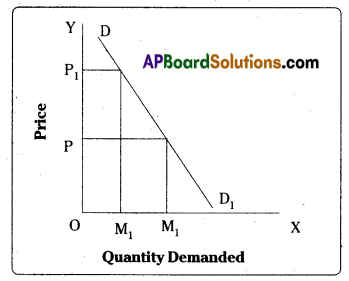
As shown in the above diagram* demand of slopes downwards from left to right, indicating inverse relationship between price and quantity demanded.
Exceptions of Law: The law of demand does not apply in this following cases.
- Giffen goods used by poor people.
- Prestige goods used by rich people.
- Speculation.
- Trade cycles.
- Illusion of the consumers.
Question 2.
Explain the Exceptions to the Law of Demand or Price Demand. [Mar. 19 (TS): May, Mar. 17]
Answer:
The law of demand states that there is an inverse or opposite relationship between price and quantity demanded, other things remaining the same. The law states that the demand curves slopes downwards from left to right.
Exceptions to the law of demand:
1) Giffen goods: The law of demand is not applicable to giffen goods. In the case of giffen goods, a fall in their price leads to a decrease in their demand.
2) Veblen goods: (Prestige goods): The law of demand does not apply in the case of costly product purchased by rich people. If the price of costly diamonds purchased by rich people increases, the demand for such diamonds also increases.
3) Speculation: If the price of the good is increasing and likely to increase further in future, speculators purchase large quantity even at the higher price.
4) Illusion: Some consumer, with wrong illusion, purchase less quantity.of a good whose price has decreased with the wrong illusion that quality will also be reduced or quality of the good also decreases.
Question 3.
Why does a Demand Curve have a negative slope or why does a Demand Curve slope downwards ? [Mar ’19 (AP); Mar ’18; May ’16]
Answer:
The law of demand states that there is an inverse or opposite relationship between the price and quantity demanded. In other words, demand curve slopes downwards left to right.
Reasons for the downward slope or demand curve: Demand curve slopes downwards because of the following reasons.
a) New buyers: Demand curve slope downwards because when price falls new buyers are attracted to the product or new buyers will also purchase the product.
b) Old buyers: When the price decreases’old buyers purchases more quantity than before. So, demand curve slopes downwards.
c) Income effect: When a price of a product decreases, there will be saving in expenditure to the consumers. This saving can be treated just like an increase in the income. In other words, real income of the consumer increases. So, the consumer purchases more quantity of good whose price has decreased.
d) Substitution effect: When the price of a good (tea) decreases, the other related product (coffee) becomes relatively costlier. So consumer purchases more quantity of tea and less quantity of coffee, which has become relatively costlier.
e) Law of diminishing marginal utility: Demand curve slopes downwards from left to right also because of this law. According to the law, when the consumers are using continuously additional units of the same product, the marginal utility of additional units gradually decreases. So, at smaller quantity, consumer is prepared to pay higher price. But at larger quantities, he is prepared to pay a lower price because there he gets lesser marginal utility.
f) Multiple uses of a commodity: Goods like coal, milk, electricity have multiple uses. . When prices of such goods decrease, consumers use such goods to more uses than before.
![]()
Question 4.
Explain the Concept of Income Demand.
Answer:
Income Demand shows the functional relationship between a change in the income of the consumer and a change in quantity demanded.
ID = f (y)
ID = Income Demand,
Y = Income of the Consumer,
f = function.
Income demand curves is of 2 types.
Normal goods: In the case of Normal goods an increase in the income of the consumer leads to an increase in the quantity purchased of such good. Income demand curve for normal goods slope upwards from left to right as shown below.

Inferior goods: In the case of inferior goods, an increase in the income of the consumer leads to a decrease in the quantity purchased of the good. Income demand curve for Inferior goods slopes downwards from left to right as shown below.

Question 5.
Explain the Concept of Cross Demand.
Answer:
Cross Demand shows the functioned relationship between the change in the price of one . good (coffee) and change in the demand of its related good (Tea).
Dc = f(Pt)
Dc = Demand for coffee, Pt Price of tea, f = function.
Cross Demand curve is of two types – either upward sloping or downward sloping.
Substitutes: Substitutes are those goods that are used in the pllace of some other good. E.g: Coffee &Tea. If there is an increase in the price of coffee, demand for tea increases. Cross Demand Curve for substitute slopes upwards from left to right as shown below.
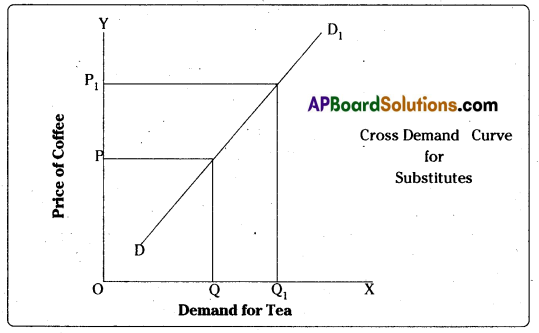
Complementary goods: Complementary goods are two or more goods used by the consumer simultaneously to satisfy the same want. E.g: Bread and jam. If the price of Bread increases, the demand for Jam decreases.
Cross Demand curve for complementary goods slopes downwards as shown below.
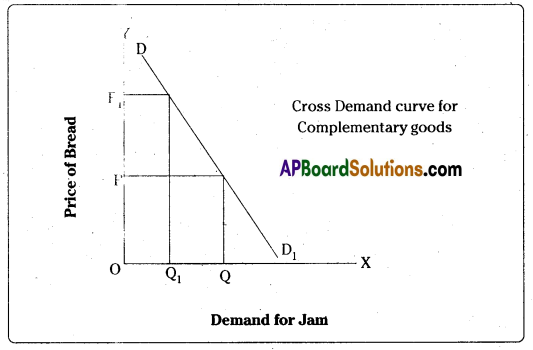
Question 6.
What are the factors that Determine Demand? [March 2018, 2017]
Answer:
The following are some of the factors that determine the demand for a good.
1) Price of the good: The most important determinant of demand of any good is the price. Price and demand are inversely related. If price increases, demand contracts and if price decreases demand expands.
2) Prices of related goods (Substitutes & Complementary goods): Demand for a good depends not only on its price but also on the prices of substitutes and complementary goods. If the price of tea (substitute of coffee) decreases, demand for coffee decreases. In the same way, when the price of jam increases (complementary good of Bread) demand for the Jam decreases.
3) Income of the consumer: An other important determinant of demand is the income of the consumer. Income and demand are directly related. If income increases demand increases and vice versa.
4) Tastes and preferences: A change in the tastes and preferences of the consumer leads to a change demand for goods. A change in the preference and tastes of the consumer towards cell phones results in a fall in the demand for landline phones.
5) Population: The size of population of the country is another determinant of demand. If population increases, demand for many goods increases.
6) Technology changes: An improvement in technology, by leading an improvement in quality and reduction cost of production and selling price, leads to an increase in demand for goods.
7) Changes in weather conditions: Demand for a good is also determined by weather conditions. Air conditioners, cool drinks, etc. will have higher demand during summer. The demand for woolen clothes increases during winter.
8) State of Business: In a period of Economic depression, demand for goods contracts and in a period of Economic property, the demand for goods increases.
Question 7.
What is Elasticity of Demand ?
Answer:
The degree to which quantity demanded responds to a change in price is known as elasticity of demand.
In other words “The elasticity of demand is the ratio of the percentage change in the quantity demanded to the percentage change in price”.
Mathematically, if can be expressed as, price elasticity of demand =

Elasticity of demand studies the relationship between proportionate or percentage change in demand and proportionate or percentage change in price.
![]()
Question 8.
Explain the three types of Elasticity of Demand.
Answer:
The degree to which quantity demanded responds to a change in price is known as elasticity of demand.
Types of Elasticity of Demand
1) Price elasticity demand: Price elasticity of demand studies the relationship between proportionate change in demand and proportionate change in price. It explains the rate of change in demand for a given change in the price of commodity.

Price elasticity demand is of five types. They are:
- Perfectly elastic or infinite elastic demand (Ed= ∞)
- Perfectly Inelastic demand or Zero Elastic demand (Ed = 0)
- Unitary elastic demand (Ed = 1)
- Relatively elastic demand (Ed > 1)
- Relatively inelastic demand (Ed < 1)
2) Income elasticity of demand: Income elasticity of demand explains the relationship between percentage/proportionate change in demand and percentage/proportionate change income.

Income elasticity of demand is positive for normal goods. But in the case of inferior goods, income elasticity of demand is negative.
3) Cross elasticity of demand: Cross elasticity of demand studies the relationship between percentage or proportionate change in demand of a product (E.g: Coffee) because of a percentage or proportionate change in the price of its related good. (E.g: tea)
Cross elasticity of demand =

Related goods are two types. They are
- Substitutes and
- Complementary goods.
Question 9.
Define Price Elasticity of Demand. Explain briefly various types of Price Elasticity of Demand. [Mar ’19 (AP)]
Answer:
The term price elasticity of demand shows or indicates the reaction or responsiveness of demand to a change in the price of the good. It can be defined as the ratio of the proportionate change in quantity demanded to the proportionate change in price.
Types / Forms of price elasticity of demand:
1) Perfectly elastic or infinite elastic demand: A product is said to have perfectly elastic or infinite elastic demand when demand changes infinitely with no change (sometimes slight change) in price. Perfectly demand curve a horizontal straight line parallel to X – axis. Its numerical value is infinite. Ed = ∞ .
2) Perfectly inelastic or zero elastic demand: A good is said to have perfectly inelastic (or zero elastic demand), when the demand of the good does not change even though price change repeatedly many times. Perfectly inelastic demand curve is a vertical straight line parallel to Y – axis . Its numerical value is zero. Ed = 0.
3) Relatively elastic demand: When the proportionate change in the quantity demanded is greater (more) than the proportionate change in price, it is known as relative elastic demand, Relatively elastic demand curve is more flatter and its numerical value is more than one. Ed > 1.
4) Relatively inelastic demand: If the proportionate or percentage change in quantity . demanded is less than the proportionate or percentage change in price, it is known as relatively inelastic demand. Relatively inelastic demand is more steeper ahd its numerical value is less than one. Ed < 1.
5) Unitary elastic demand: If the proportionate or percentage change in quantity demanded is equal to proportionate or percentage change in price, it is known as unitary elastic demand. Unitary elastic demand curve is a rectangular hyperbola and its numerical value is one. Ed =1.
Question 10.
Explain the Total Outlay Method of Measuring Elasticity of Demand. [May 2018, 2016]
Answer:
The degree of sensitiveness or responsiveness of demand to a change in the price of a good is known as (price) elasticity of demand. In the words, elasticity of demand is the ratio of the percentage/ proportionate change in the quantity demanded and proportionate / percentage change in the price.
Outlay Method: (Expenditure Method): This method is associated with the name of Alfred Marshall. Under this method, elasticity of demand of a good can be calculated/ measured by finding out whether the expenditure made on the good increases, decreases or remains constant with a change in the price of the good.

In the above diagram, on Y – axis price is shown and on X – axis is outlay or expenditure made is shown.
1) When the price has decreased 1st time from Rs. 4 to 3, the outlay expenditure made on the good has increased from Rs. 4000 to Rs. 6000. If a decrease in the price leads to an increase in expenditure (vice versa), the good will have (relatively) elastic demand. (Ed > 1)
2) When the price has decreased, 2nd time from Rs. 3 to Rs 2/- there is no change in expenditure of outlay made on the good. In this way, if a change (either increase/ decrease) in price leads to no change in expenditure or outlay, the good will have unitary elastic demand. (Ed = 1)
3) When in the price has decreased 3rd time, from Rs. 2 to Rs. 1, the expenditure or outlay made on the good has also decreased from Rs. 6000 to Rs. 4000/-. In this way, if a decrease in price leads to decrease in expenditure/outlay (vice versa), the good will have (relatively) inelastic demand. (Ed < 1)
Question 11.
Explain the Point Method of measuring price Elasticity of Demand, (or) How do you measure Elasticity of Demand on straight line Demand Curve? [May 2017]
Answer:
Price elasticity of demand shows the responsiveness of quantity demanded to changes in price. In other words, it is the ratio proportionate of percentage change in quantity demanded and proportionate (percentage) change in price.
Point method: This method was suggested by Alfred Marshall. Under this method, the elasticity of demand at a point can be calculated measured by dividing the (length of) lower segment of the demand curve with the (length of) upper segment of the demand curve. To calculate elasticity of demand, a point is placed on the demand curve and such point divides the demand curve in to two parts, namely, a lower part and an upper part.
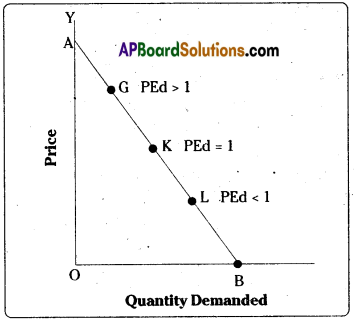
1) In the above diagram, at the middle point of the demand curve (K) PEd = 1. This is because at point K (the mid point) the lower segment of the demand curve (KB) is equal to the upper part of the Demand curve (KA).
KA/KB=1, PEd = 1
2) At a point above the middle point (G), Price elasticity of demand is greater than one (Ed > 1). This is because at point G the lower part of the demand curve, GB is more than the upper segment / part of the demand curve(GA). GB > GA, PE > 1. GB/GA = more than one, Ed > 1.
3) At a point below the mid point of the demand curve, price elasticity of demand is less than one. This is because at point L, the length of the lower segment of the demand curve (LB) is less than the length of the upper part of the demand curve (LA).
LB/LA = less than one, PE < 1.
![]()
Question 12.
What are the basic Determinants of Elasticity of Demand ?
Answer:
The degree to which quantity demanded responds or reacts to a change in price is known as elasticity of demand.
In other words, elasticity of demand is the ratio of proportionate / percentage change in quantity demanded and proportionate / percentage change in price.
Determinants of elasticity of demand:
1) Nature of the commodity: If the good is a necessity, it will have inelastic demand. If the good is a luxury, it will have elastic demand.
2) Existence of substitutes: If a good is having many or more substitutes, it will have elastic demand. Goods with few substitutes will have inelastic demand.
3) Number of uses: Goods, which are having many or multiple uses, generally have elastic demand. But goods which have one or two uses will have inelastic demand.
4) Possibility of postponement: Goods, whose purchases are not postponable, normally have inelastic demand. But goods whose purchases can be postponed have elastic demand.
5) Time element: Generally, in the short run, goods will have inelastic demand. But the same, products will have elastic demand in the long rpn.
6) Complementary of goods: If the goods are complementary that are used simultaneously, they have inelastic demand.
7) Level of Price: If the price of good is very high (at a higher price level) the demand tends to elastic. Goods, whose price are very low (Eg: Slat, matchbox) have inelastic demand.
8) Proportion of total expenditure on the good: If a consumer spends a large portion of his income on a single good, that good will have elastic demand. But a good on which a very small percentage of total income is spent will have inelastic demand.
Question 13.
Explain the importance of the Concept of Elasticity of Demand. [Mar ’19 (TS)]
Answer:
The term elasticity of demand shows the responsiveness or reaction of quantity demanded of a good to a change in the price of that good, or income of the consumer or prices of related goods. ”
Importance of elasticity of demand: The concept of elasticity of demand has several uses.
1) To business people in fixing the price of the good: The concept of useful to business people in fixing the price of the good. If the good is having elastic demand, they can change a lower price. If the good possesses inelastic demand, they change a higher price.
2) To monopolist in price discrimination: A monopolist, following the policy of price discrimination* charges higher price in that sub -market where in good is having inelastic demand. But in the sub – market where the product is having elastic demand, he charges a lower price.
3) Pricing of joint products: In the case of joint products, it is not possible to know the cost of production separately. A businessman charges a lower price to one of the joint products which is having elastic demand and higher price to that good having inelastic demand.
4) Nationalisation decisions: The concept is also useful to the government in making decisions relatingtonationalisation of privatesector organisations. Thegovernment nationalises those industries whose goods are having inelastic demand.
5) International Trade: The concept of elasticity of demand is useful to the government in matters of foreign trade like terms of trade, exchange rates, etc.
6) To Finance Minister in tax matters: It helps the Finance Minister in determining the tax rates on different goods. The Financial Minister imposes higher taxes on the goods having inelastic demand. He charges or imposes lower rates of taxes on goods which possess elastic demand.
7) To trade unions in wage bargains: The concept is useful to the trade unions of workers in wage bargains. Workers can demand steep increase in their wages if the product produced by them possesses inelastic demand. But workers have to satisfy with lesser hike in their wages if the goods produced by them possess elastic demand.
Very Short Answer Questions
Question 1.
Demand.
Answer:
The term “Demand” is a bi*oad concept which includes in itself desire, willingness and ability to buy a good. The term demand refers to the quantity of good which a consumers is prepared to buy at given prices in a given market at a given time.
Question 2.
Demand Schedule. [March 2017]
Answer:
The term demand schedule is simply a table which shows the different quantities prepared to be purchased by the consumer at different prices. Demand schedule is the basis of demand curve.
Question 3.
Individual Demand Schedule. [May 2018]
Answer:
Individual demand schedule is a table which shows the different quantities prepared to be purchased by a individual/single consumer at different prices in a given place at a given time.
![]()
Question 4.
Market Demand Schedule.
Answer:
Market demand schedule is a table which shows the total demand for a good at different prices at a particular time in a particular market. It is sum total of quantities demanded by various consumers in a market at different prices.
Question 5.
Demand Function. [Mar ’19 (TS); May 2016]
Answer:
Demand function is Mathematical equation which shows the functional relationship between the demand of a good and the determinants of that good.
Question 6.
Giffen Paradox (or) Giffen Goods. [Mar ’19 (AP); May, Mar ’18; May ’16]
Giffen goods are those inferior goods used by poor people, invented by and named after Sir Robert Giffen. The law of demand does not apply in the case of giffen goods. For such goods an increase in price leads to an expansion of their demand.
Question 7.
Veblen Goods (Prestigious goods).
Answer:
Prestigious goods, are also known as Veblen goods, are those costly goods used by rich people. For such goods the law of demand does not apply. Rich people purchase more of such goods even at increased prices since they are not worried about money expenditure.
Question 8.
Speculation.
Answer:
Speculation is simply buying at lower prices with the objective of selling goods, shares, etc. at higher prices. Such buying & selling is undertaken to earn speculative profits. The law of demand does not apply in the case of speculation.
Question 9.
Price Demand.
Answer:
Generally demand means price demand. Price demand refers to different quantities of a particular commodity purchased by a consumer at a given time, in a market at different prices. Price demand states that there is art opposite and inverse relationship between price and quantity demanded. Price demand curve slopes downwards from left to right.
Question 10.
Income Demand. [March 2017]
Answer:
Income demand refers to the various quantities of a good which a consumer purchases at different levels of his income. Income demand curve states that there is direct and positive relationship between income and quantity demanded. Income demand curve ‘ for normal goods slopes upwards from left to right and for inferior goods, it slopes downwards from left to right.
Question 11.
Cross Demand. [March 2018, May 2017]
Answer:
Cross demand refers to the changes in the quantity demanded of a good (coffee) due to the change in price of its related good (Tea). The cross demand curve for substitutes slopes upwards from left to right and for complementary goods, it slopes downwards from left to right.
Question 12.
Substitutes.
Answer:
The goods which are used in the place of some other goods are known as substitutes. E.g.: Coffee and tea.
It is quite natural that a person drinks tea when coffee is not available.
Question 13.
Complementaries.
Answer:
Complementary goods are two or more goods used simultaneously to satisfy the same (or) single want by a consumer.
E.g.: The desire of having break fast can be satisfied with the use of three goods namely bread, jam and coffee.
Question 14.
Inferior Goods.
Answer:
Inferior goods are low quality goods. In the case of inferior goods, demand increases with a fall in income and their demand decreases with a rise in income of the consumer. The income demand curve for inferior goods will be having a negative slope and it slopes downwards from left to right.
Question 15.
Elasticity of Demand.
Answer:
The term elasticity of demand simply refers to the reaction or responsiveness of demand for a given change in any one of the determinants of demand. It can be understood as the ratio of proportionate change in quantity demanded to proportionate cfiange in price (income, price of related goods).

Question 16.
Price Elasticity of Demand. [May 2017]
Answer:
Price elasticity demand shows or indicates the responsiveness or reaction in the quantity demanded to the change in price. It is the ratio of proportionate change in quantity demanded to the proportionate change price.

![]()
Question 17.
Income Elasticity of Demand.
Answer:
The term income elastic demand shows or indicates the responsiveness or reaction in the quantity demanded to a change is income. It is ratio of proportionate change in quantity demanded and proportionate change in income.

Question 18.
Cross Elasticity of Demand.
Answer:
Cross elastic demand shows or indicates the responsiveness (or) reaction in quantity d demanded of a good X (coffee) to a change in the price of related good Y (tea). It is the ® ratio of proportionate change in quantity demanded of coffee and proportionate change in price of tea.

Question 19.
Perfectly Elastic Demand.
Answer:
A good is said to be having perfectly elastic (infinite elastic) demand, when its demand ‘ increases infinitely due to a slight change (or) no change in price. Perfectly elastic . (Infinite elastic) demand curve is horizontal straight line parallel to X – axis and its numerical value is infinite Ed = ∞.
Question 20.
Perfectly Inelastic Demand.
A.
If the demand for a good does not change even after significant increase or repeated increases in rice, it is said to be having perfectly inelastic (zero elastic) demand. Perfectly inelastic demand curve is a vertical straight line parallel to Y – axis and its numerical value is zero, Ed = 0.
Question 21.
Unitary Elastic demand.
Answer:
When the proportionate change is quantity demanded is equal to proportionate change is price, it is known as unitary elastic demand. It numerical value is 1. Such a demand curve is like a rectangle hyperbola Ed = 1.
Question 22.
Relatively Elastic Demand.
Answer:
If the proportionate percentage change in quantity demanded is more than the proportionate change in price, it is known as relatively elastic demand. Such a demand curve will be more flatter with its numerical value of more than 1 (Ed > 1).
Question 23.
Relatively Inelastic Demand.
Answer:
When the proportionate change in quantity demanded is less than the proportionate change in price, it is known as relatively inelastic demand. Such as a demand curve will be more steeper with a numerical value less than 1 (Ed < 1).
Question 24.
Arc Method. [Mar ’19 (AP)]
Answer:
Arc method is a method of calculating the elasticity of demand in which elasticity is calculated in a portion (or) segment of demand curve between, two points of the demand curve. In other words, in this method, elasticity is calculated at the Mid point of an arc of a demand curve.
![]()
Question 25.
Importance of Price Elasticity of Demand.
Answer:
The concept of price elasticity demand is useful in the fixation of price of goods, to a. moriopolist, to the Finance Minister in levying taxes on different goods, in the fixation of prices of joint products, and in international trade, etc.
